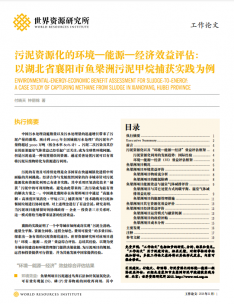Environment-Energy-Economic Benefit Assessment for Sludge-to-Energy
A Case Study of Capturing Methane from Sludge in Xiangyang, Hubei Province

Xiangyang City of Hubei Province is perhaps the first developing country city that tested out the idea of effective and sustainable sludge treatment by investing in a “high temperature thermal hydrolysis + highly concentrated anaerobic digestion + methane capture and utilization” pathway through which co-digested sludge and kitchen waste have been rendered harmless to the local, regional and global environment. The World Resources Institute was invited to independently review the energy, environment and economic benefits of the Xiangyang case, and this report summarizes Xiangyang’s experiences, and provides insights on how other cities in China and in other developing countries facing similar challenges can address their sludge disposal problems in a sustainable manner.
Executive Summary
Rapid urbanization in China has generated substantial quantities of liquid wastes in municipalities, and along with it massive investments in wastewater conveyance and disposal. This increase in the number of wastewater treatment plants needed to treat the generated wastewater has led to the emergence of a significant volume of sludge, as the byproduct of the treatment process. The secondary pollution and the significant greenhouse gas effects caused by sludge have become global environmental issues. However, sludge can also be turned from waste into resources if it is treated properly.
Through the analysis of the Yuliangzhou Project in Xiangyang City, Hubei Province, China, the key findings are shown below:
- Xiangyang project successfully achieve the goals of financial viability of the enterprise, sludge stabilization through pollutant reduction, resource recovery, close to zero net carbon emission from the wastewater system, and renewable energy generation in the city
- Joint support from the government and market is efficient in solving the funding challenge of sludge project
- The “market perspective” treatment roadmap for sludge ensures the economic benefit of the project